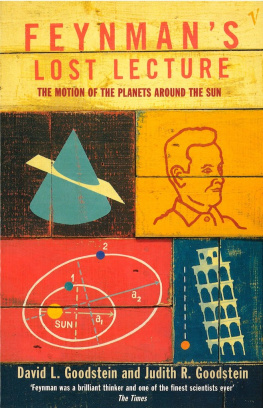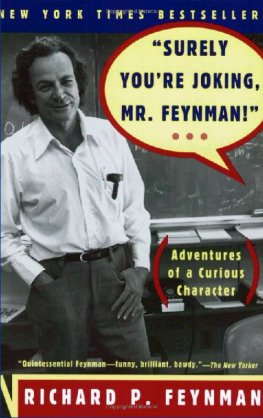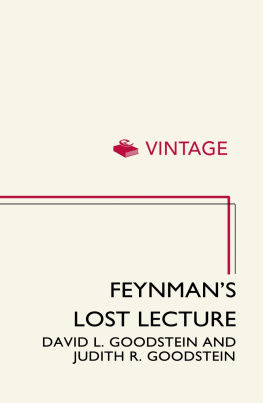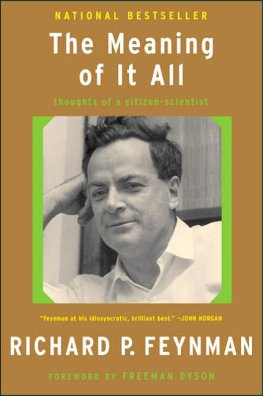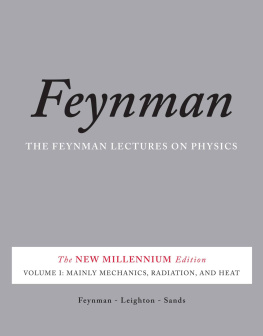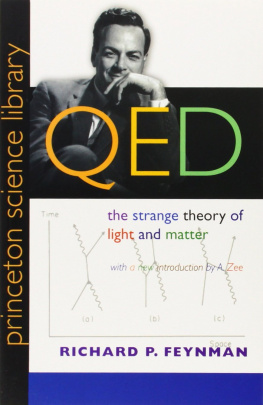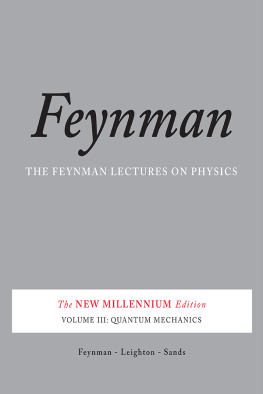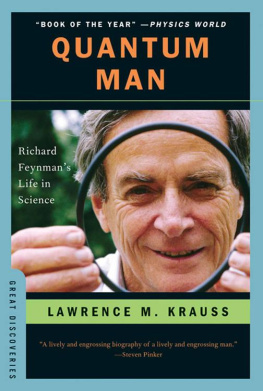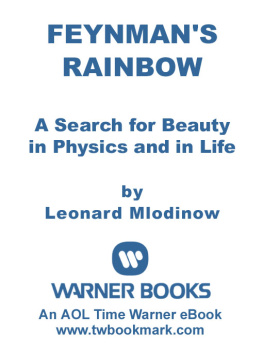Contents
From Copernicus to Newton
Feynman: A Reminiscence
Feynmans Proof of the Law of Ellipses
The Motion of Planets Around the Sun ( M ARCH 13, 1964)
About the Book
On 14 March 1964 Richard Feynman, one of the greatest scientific thinkers of the 20th Century, delivered a lecture entitled The Motion of the Planets Around the Sun. For thirty years this remarkable lecture was believed to be lost. But now Feynmans work has been reconstructed and explained in meticulous, accessible detail, together with a history of ideas of the planets motions. The result is a vital and absorbing account of one of the fundamental puzzles of science, and an invaluable insight into Feynmans charismatic brilliance.
About the Authors
Winner of the Nobel Prize for Physics, the late Richard Feynman taught for many years at the California Institute of Technology. He is best known to a wide readership as the author of Surely Youre Joking, Mr Feynman! and What Do You Care What Other People Think.
Dr. David Goodstein is Vice Provost and Professor of Physics at the California Institute of Technology. Dr. Judith Goldstein, registrar and archivist at Caltech, is author of Millikans School: A History of the California Institute of Technology.
BY DAVID L. GOODSTEIN
The Mechanical Universe and Beyond
(PBS television series)
States of Matter
BY JUDITH R. GOODSTEIN
Millikans School
To the memory of R.P.F.,
who would be appalled that we found it
necessary to explain what he had
said so clearly.
Preface
This is the story of how Feynmans lost lecture came to be lost, and how it came to be found again. In April 1992, as Caltechs archivist, I was asked by Gerry Neugebauer, the chairman of the Physics Department, to go through the files in Robert Leightons office. Leighton was ill and had not used his office for several years. Marge Leighton, his wife, had told Neugebauer that it was all right to clean out the officeshed already collected her husbands books and personal effects. I could take what I wanted for the archives, and the Physics Department would dispose of the rest.
Besides heading the Physics Department from 1970 to 1975, Leighton, together with Matthew Sands, had overseen the editing and publication of Richard Feynmans two-year course of lectures in introductory physics, delivered to Caltech freshmen and sophomores. The lectures, published in the early 1960s in three volumes by Addison-Wesley, dealt with virtually every subject in physics, with a point of view that remains fresh and original to this day. I was hoping to find some tangible evidence of the Leighton-Feynman collaboration.
It took me a couple of weeks to sift through the stacks of paper, which were stashed everywhere, but Leighton didnt disappoint me. I unearthed two folders, one marked Feynman Freshman Lectures, unfinished , another labeled Addison-Wesley, wedged between budget sheets and purchase orders from earlier decades and reams of yellowing computer paper covered with endless columns of numbers, all thrown together in a storage closet just outside his office. Leightons correspondence with the publisher contained details about the format, the color of the cover, comments by outside readers, adoptions at other schools, and estimates of how well the volumes would sell. That folder I put in the Save pile. The other folder, the one containing the unedited Feynman physics lectures, I carried back to the archives myself.
In his June 1963 preface to The Feynman Lectures on Physics, Feynman commented on some of the lectures not included there. Hed given three optional lectures in the first year on how to solve problems. And, indeed, three of the items in Leightons folder turned out to be the raw transcripts for Reviews A, B, and C, offered by Feynman in December 1961. A lecture on inertial guidance, which Feynman gave the following month, didnt make the cut eitheran unfortunate decision, according to Feynmanand I found a partial transcript of this lecture in Leightons folder. The folder also contained the unedited partial transcript of a later lecture, dated March 13, 1964, along with a sheaf of notes in Feynmans handwriting. Entitled The Motion of Planets Around the Sun, it was an unorthodox approach to Isaac Newtons geometric demonstration of the law of ellipses, in the Principia Mathematica.
In September 1993, I had occasion to draw up a list of the original audiotapes of the Feynman lectures, which had also been contributed to the archives. They included five lectures that were not to be found in the Addison-Wesley books. Then I remembered the five unpublished lectures in Leightons file; sure enough, the unedited transcripts matched the tapes. The archives also had photographs of the blackboard diagrams and equations for four of these lecturesthe four mentioned by Feynman in his prefacebut I could find none for the March 1964 lecture on planetary motion. (In the course of selecting illustrations for this book, I did stumble upon one photograph of Feynman taken during this special lecture. It is reproduced here as the frontispiece.) Although Feynman had given Leighton his notes on the 1964 lecture, which included sketches of his blackboard drawings, Leighton apparently decided not to include it in the last (1965) volume of The Feynman Lectures on Physics, which dealt primarily with quantum mechanics. In time, this lecture was forgotten. For all practical purposes, it was lost.
The idea of rescuing all five unpublished Feynman lectures from oblivion appealed to David and me. So the following December, when we went, as we often do, to the Italian hill town of Frascati, we took along copies of the tapes, the transcripts, the blackboard photographs, and Feynmans notes. In the course of the next two weeks, we listened to the tapes, took notes, laughed at the jokes, strained to hear the students questions and Feynmans answers after each lecture was over, took more notes. But in the end, we decided that the only lecture that still had the vitality, originality, and verve we associated with Feynmans presence in the classroom was the 1964 lecture on planetary motionthe one lecture that demanded a full complement of blackboard photographs. And we didnt have them. Reluctantly, we abandoned the project.
Or so I thought. As it turned out, bits and pieces of the lecture haunted David, especially when he came to teach the same material in freshman physics the following year. He had the tape. But could he reconstruct the blackboard demonstrations from the few tantalizing sketches in Feynmans notes and the few words Feynman had jotted down more for himself than for the students? Lets try again, he announced, early in December 1994, as we were packing for a trip through the Panama Canal. This time, we would take along only the transcript of the 1964 lecture, the lecture notes, and selected pages from Keplers The New Astronomy and Newtons Principia for good measure.
It took the S.S. Rotterdam eleven days to sail from Acapulco to Fort Lauderdale. For two to three hours each day, David would hole up in our cabin and work on deciphering Feynmans lost lecture. He began, as Feynman had, with Newtons geometrical proofs. The initial break came when he was able to match up Feynmans first sketch with one of Newtons diagrams, on of the Cajori edition of the

